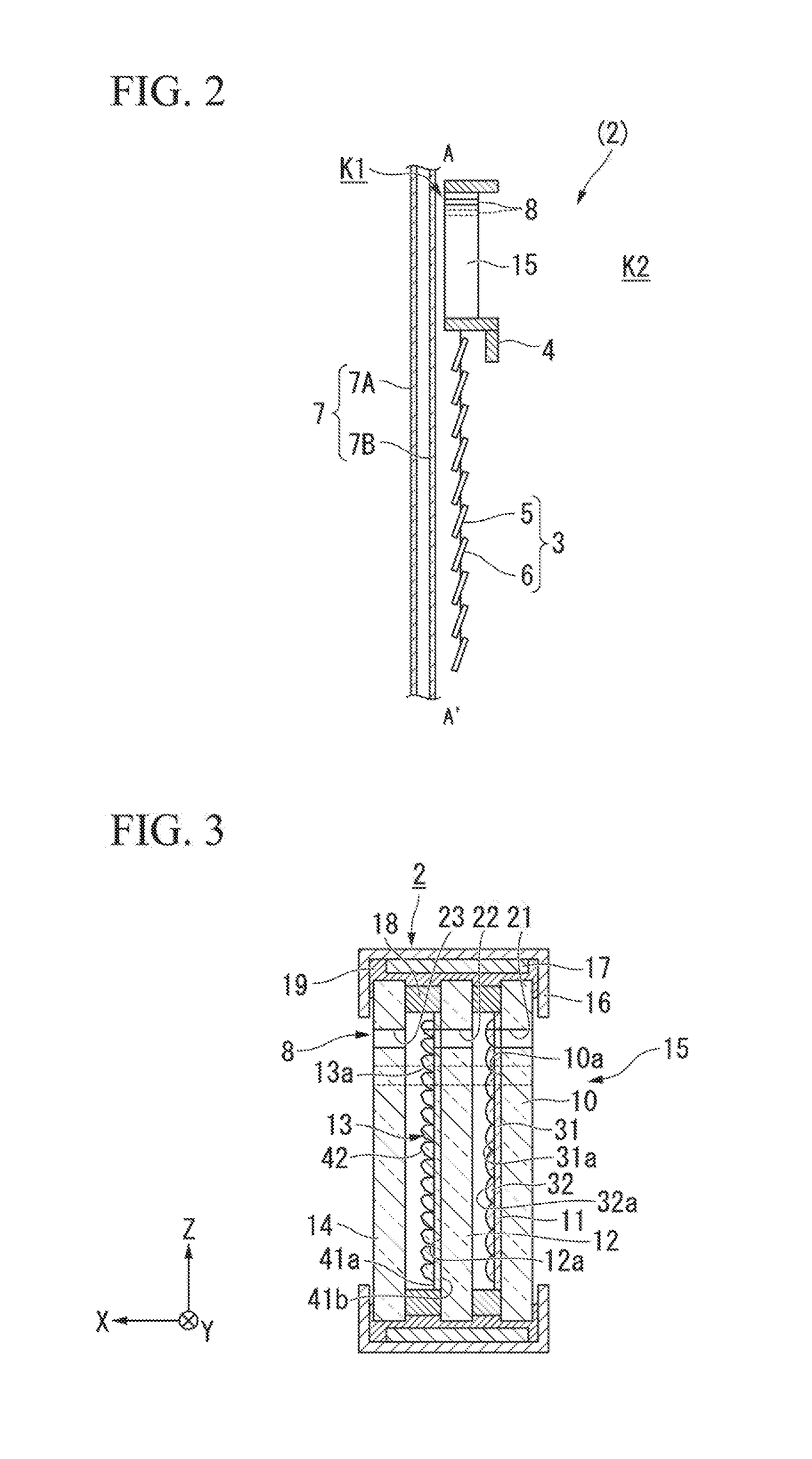Daylighting device
a daylighting and glass window technology, applied in the field of daylighting devices, can solve problems such as and achieve the effect of suppressing temperature increases and preventing thermal cracking of window glass
- Summary
- Abstract
- Description
- Claims
- Application Information
AI Technical Summary
Benefits of technology
Problems solved by technology
Method used
Image
Examples
first embodiment
[0079]A daylighting device of the present embodiment is installed, for example, on a part of a window of an office building to guide sunlight into the building's interior.
[0080]FIG. 1 is a perspective view of the exterior of a window on which a daylighting device of a first embodiment is installed. FIG. 2 is a cross-sectional view taken along line A-A′ in FIG. 1.
[0081]As shown in FIGS. 1 and 2, a daylighting device 2 is installed on a window frame 101 via an attaching unit 1, and a window shade 3 is disposed on a lower portion of the daylighting device 2. Take, as an example, a typical office room with a window that measures 270 cm in height (from the floor to the ceiling). The daylighting device 2 is located over the range of 70 cm from the ceiling. The window shade 3 covers approximately 200 cm below the daylighting device 2. The window shade 3 is attached to the bottom of the daylighting device 2, for example, via a pair of fixtures 109. The fixtures 109 are omitted in FIG. 2.
[00...
second embodiment
[0182]Next will be described the structure of a daylighting device in accordance with a second embodiment of the present invention.
[0183]FIG. 19 is a schematic cross-sectional view of the structure of the daylighting device of the second embodiment.
[0184]A daylighting device 20 of the present embodiment has a basic structure that is substantially the same as that of the daylighting device of the first embodiment, but differs in that the gaps between glass plates in which through holes are formed are sealed. The following description will elaborate on differences and skip over common features.
[0185]As shown in FIG. 19, in the daylighting device 20, there are provided sealing members 26, one between the first glass plate 10 and the second glass plate 12 and another between the second glass plate 12 and the third glass plate 14, so as to constitute a part of each ventilation hole 8. The ventilation hole 8 includes a through hole 21 in the first glass plate 10, a through hole 22 in the ...
third embodiment
[0190]Next will be described the structure of a daylighting device in accordance with a third embodiment of the present invention.
[0191]FIG. 20A is a schematic cross-sectional view of the structure of the daylighting device of the third embodiment. FIG. 20A is a cross-sectional view of the daylighting device as viewed from a ceiling end thereof.
[0192]A daylighting device 30 of the present embodiment has a basic structure that is substantially the same as that of the daylighting device of the first embodiment, but differs in that the through hole(s) formed in one / some of the glass plates has / have a different size from the size of the through holes formed in the other glass plates. The following description will elaborate on differences and skip over common features.
[0193]As shown in FIG. 20A, in the daylighting device 30, the through hole 21 in the first glass plate 10 having the light-diffusion sheet 11 thereon is smaller in size than the through holes 22 and 23 formed in other glas...
PUM
 Login to View More
Login to View More Abstract
Description
Claims
Application Information
 Login to View More
Login to View More - R&D
- Intellectual Property
- Life Sciences
- Materials
- Tech Scout
- Unparalleled Data Quality
- Higher Quality Content
- 60% Fewer Hallucinations
Browse by: Latest US Patents, China's latest patents, Technical Efficacy Thesaurus, Application Domain, Technology Topic, Popular Technical Reports.
© 2025 PatSnap. All rights reserved.Legal|Privacy policy|Modern Slavery Act Transparency Statement|Sitemap|About US| Contact US: help@patsnap.com



